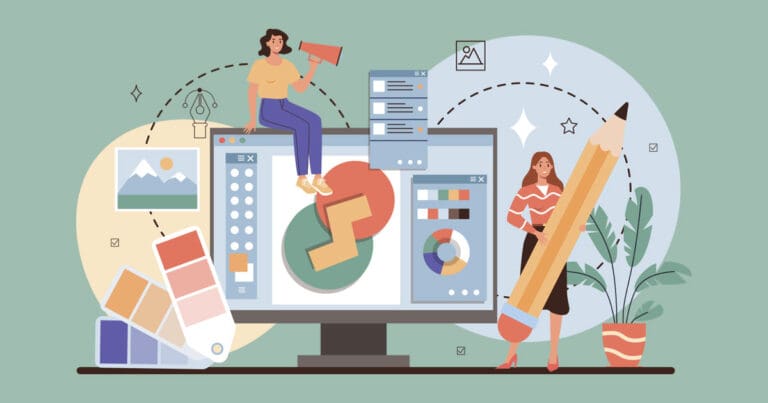Graphic Designers: Job Description, Salary & Career Paths

With the ever-growing popularity of social media and digital marketing, businesses need professionals who can create visually appealing and effective graphics.
This is where hiring graphic designers to create a powerful brand identity becomes crucial for businesses looking to stand out from the competition.
But what do these digital artists do, exactly? What education and training is needed to become a one? And what are some graphic designer career growth opportunities for someone with these skills?
Here’s everything you need to know about graphic design as a career path:
- What does a graphic designer do?
- What is graphic design?
- Job description components
- Graphic designer job description example
- Where can graphic designers work?
- Graphic designer salaries
- Graphic design job growth opportunities
What does a graphic designer do?
A graphic designer creates visual concepts, using computer software or by hand, to communicate ideas that inspire, inform, and captivate consumers.
They develop the overall layout and production design for advertisements, brochures, magazines, corporate reports, digital media, and sometimes motion graphics.
These professionals also select the colors, images, text style, and layout of websites and printed pages.
What is graphic design?
Graphic design is the process of creating visual content to communicate a message or idea. It involves combining text, images, and layout in order to create visually engaging communication pieces.
- Employers can benefit from graphic design by having professionally designed materials that appeal to their target audience and convey their desired message.
- Job seekers should be aware of the key skills needed for effective graphic design such as typography, color theory, composition, illustration, and photo editing.
Graphic designer job description components:
A graphic designer job description should include, education and training, certifications, duties and responsibilities, as well as hard skills and soft skills.
Education & training
Most have at least a bachelor’s degree in graphic design or a related field though an associate’s degree is also acceptable in many cases.
There are also instances where a traditional degree is not necessary as long as you’re able to demonstrate that you’ve had some formal training.
While there are exceptions to the rule, most entry-level positions require an associate’s degree or a postsecondary certificate.
Graphic design certifications
There are a number of voluntary professional certifications available to anyone looking to set themselves apart from other candidates.
Some of the most popular certifications include:
- Certified Graphic Designer (CGD)
- Registered Graphic Designer (RGD)
- Certified Professional in Learning and Performance (CPLP)
- Master Graphic Designer (MGD)
These certifications can demonstrate to employers that a designer has the necessary skills and knowledge to excel in the field.
Duties & responsibilities
Some common duties and responsibilities associated with a this role are:
- Meeting with clients or art directors to discuss the goals and objectives of a project
- Developing creative concepts and designs based on client needs
- Using computer software to create layouts, designs, logos, illustrations, and other graphics
- Selecting colors, images, text style, and layout
- Incorporating changes suggested by clients or art directors into final designs
- Proofreading designs for errors before printing or publishing them
It should be noted, the specific duties and responsibilities of a this role vary depending on the industry they work in and the type of project they are working on.
Hard skills
In order to be successful in these roles, you should possess the following hard skills:
- Knowledge of design principles and aesthetics
- Proficiency in graphic design software, such as Adobe Photoshop and Illustrator
- Strong typographic skills
Soft skills
The most important soft skills for these roles include:
- Creativity and artistic talent
- Communication and interpersonal skills
- Time management and organizational skills
- Problem-solving ability
Graphic designer job description example:
Our company is looking for a driven and experienced graphic designer to join our marketing team to help us create stunning visuals for our website and social media accounts.
The ideal candidate will have a strong portfolio of work that includes logos, designs, illustrations, and other relevant graphics. They should be able to interpret our brand identity into creative works of art and have an understanding of developing campaigns for different types of platforms.
Education & Training:
- Minimum education: Bachelor’s degree in graphic design or related field. Associate’s degree or postsecondary certificate also acceptable for entry-level positions.
- Formal training in graphic design required; however, exceptional skills can substitute for traditional degree in some cases.
Graphic Design Certifications (Optional but Beneficial):
- Certified Graphic Designer (CGD)
- Registered Graphic Designer (RGD)
- Certified Professional in Learning and Performance (CPLP)
- Master Graphic Designer (MGD)
Duties & Responsibilities:
- Consult with clients or art directors on project objectives.
- Develop creative concepts and designs.
- Utilize graphic design software for creating layouts, logos, and illustrations.
- Choose appropriate colors, images, text styles, and layouts.
- Revise designs based on feedback.
- Proofread designs before finalization.
- Create engaging visuals for social media posts
- Note: Duties vary by industry and project type.
Hard Skills:
- Strong grasp of design principles and aesthetics.
- Proficiency in Adobe Photoshop, Illustrator, and related software.
- Advanced typographic skills.
Soft Skills:
- Creativity and artistic talent.
- Effective communication and interpersonal skills.
- Time management and organizational abilities.
- Problem-solving aptitude.
This role requires a blend of technical skills and creative flair, suitable for various industries and project types. A good graphic designer should be able to translate client needs into visually appealing and effective designs.
Where can graphic designers work?
There are a number of opportunities for these professionals that include in-house marketing, marketing agencies, freelance work, and education.
In house marketing teams
In house marketing teams are internal teams which are responsible for the promotion of a company’s products and services.
A company may employ a visual designer to work closely with the rest of the marketing team to create logos, brochures, flyers, website graphics, and other marketing materials.
Marketing agencies
Marketing agencies provide services to businesses to help them achieve their marketing goals.
They often employ creative designers to create visual content for their numerous clients in order to promote their unique products and brands.
Design studios
Design studios are often hired by companies to create compelling visuals that stand out in the market or communicate a specific message.
They also provide advice on how to position a brand in the marketplace and understand user needs when designing products.
Design studios have ample opportunities for creatives these days as technology has opened up new ways of creating and sharing work, and more people than ever can access it with ease.
Freelance
Freelance designers are in high demand. Employers need professionals who can create visually appealing and effective designs for their business’s website, logo, advertisement campaigns, product packaging, and other promotional materials.
As a freelancer, you have the ability to choose your hours, rates, and the projects that interest you most as well as be your own boss.
Television and film
While the industry has changed drastically in recent years, the rise of streaming services has increased accessibility to content around the world, making the demand for visual artists and designers to create content for these services even greater.
From creating promotional materials and artwork for streaming sites to designing logos or artwork for specific series, visual artists are in demand now more than ever.
Education
The education industry is in need of subject matter experts who can help bridge the gap between traditional and modern forms of teaching.
The need for graphic designers, web developers, and other tech-savvy professionals to create content that engages students is ever growing.
These are just a few of the opportunities available in this filed as there are a variety of roles and career paths that one can take that present unique challenges and rewards.
Graphic Designer Salaries, Low & High Ranges
| Job Title | Salary Range |
| Graphic Designer Salary | $50,000-$100,000 |
| Brand Manager Salary | $70,000-$145,000 |
| Art Director Salary | $115,000-$150,000 |
| Creative Director Salary | $115,000-$190,000 |
| Product Designer Salary | $120,000-$190,000 |
Graphic design job growth opportunities
With time job growth opportunities can transition to more senior roles, including brand manager, product designer, art director and creative director.
What is a Brand Manager?
Brand managers combine graphic design expertise with digital marketing skills and are responsible for overseeing the development and execution of marketing plans to build brand awareness and equity.
What is an Art Director?
Art directors are responsible for the overall creative vision of a project.
They work with clients and other members of the creative team to come up with concepts and designs that meet the client’s objectives.
Art directors typically have a bachelor’s degree in graphic design or a related field, as well as several years of experience in the field.
What is a Creative Director?
While art directors oversee major projects, creative directors are responsible for the overall creative vision of an organization.
They work with clients, art directors, and other members of the creative team to develop concepts and designs that meet the client’s objectives.
Creative directors typically have a bachelor’s degree in graphic design or a related field, as well as several years of experience in the field.
What is a Product Designer?
Product designers combine their knowledge of graphic design, user experience, and engineering to create products that are both functional and visually appealing.
They work with clients and other members of the product development team to come up with concepts and designs for new products.
Product designers typically have a bachelor’s degree in industrial design or a related field, as well as several years of real-world experience.
Understanding graphic design jobs and salaries
If you’re in the graphic design field or you’re interested in becoming a graphic designer, you’ll find a world of opportunity open to you.
With the right skills and experience, you can land a job in just about any industry. The sky’s the limit when it comes to graphic design jobs and salaries.
The most important thing is to have a clear understanding of the role you want to play in the graphic design field to put yourself on a path to success.
Looking for your next Graphic Design gig? Let us help.
Every year, Mondo helps over 2,000 candidates find jobs they love.
- Interview Tips for Introverts: How to Ace Your Interview
- How to Write a Resume When You Have No Work Experience
- Cliche Interview Answers to Avoid & What to Say Instead
- Pandemic-Related Interview Questions & How to Answer Them
- 7 Things to Never Say to a Recruiter When Looking for a Job
- Best Questions to Ask to Impress Hiring Managers



